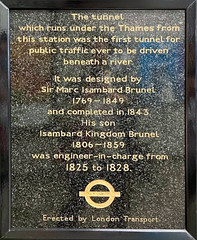

Isambard Kingdom Brunel
(1806-1859)
Died aged 53
Wikidata WikipediaIsambard Kingdom Brunel FRS MInstCE (/ˈɪzəmbɑːrd bruːˈnɛl/; 9 April 1806 – 15 September 1859) was an English civil engineer who is considered "one of the most ingenious and prolific figures in engineering history," "one of the 19th-century engineering giants," and "one of the greatest figures of the Industrial Revolution, [who] changed the face of the English landscape with his groundbreaking designs and ingenious constructions." Brunel built dockyards, the Great Western Railway (GWR), a series of steamships including the first propeller-driven transatlantic steamship, and numerous important bridges and tunnels. His designs revolutionised public transport and modern engineering. Though Brunel's projects were not always successful, they often contained innovative solutions to long-standing engineering problems. During his career, Brunel achieved many engineering firsts, including assisting in the building of the first tunnel under a navigable river (the River Thames) and the development of the SS Great Britain, the first propeller-driven, ocean-going iron ship, which, when launched in 1843, was the largest ship ever built. On the GWR, Brunel set standards for a well-built railway, using careful surveys to minimise gradients and curves. This necessitated expensive construction techniques, new bridges, new viaducts, and the two-mile-long (3.2 km) Box Tunnel. One controversial feature was the "broad gauge" of 7 ft 1⁄4 in (2,140 mm), instead of what was later to be known as "standard gauge" of 4 ft 8+1⁄2 in (1,435 mm). He astonished Britain by proposing to extend the GWR westward to North America by building steam-powered, iron-hulled ships. He designed and built three ships that revolutionised naval engineering: the SS Great Western (1838), the SS Great Britain (1843), and the SS Great Eastern (1859). In 2002, Brunel was placed second in a BBC public poll to determine the "100 Greatest Britons." In 2006, the bicentenary of his birth, a major programme of events celebrated his life and work under the name Brunel 200.
DbPedia
relative of John Calcott Horsley , friend of John Calcott Horsley and friend of Thomas Richard Guppy
Commemorated on 27 plaques
Sir Marc Isambard Brunel 1769-1849 and Isambard Kingdom Brunel 1806-1859 civil engineers lived here
98 Cheyne Walk, Kensington and Chelsea, SW10, London, United Kingdom where they lived
Isambard Kingdom Brunel 1806-1859. Great Victorian Engineer. His first project was the Thames Tunnel, the world's first underwater tunnel
Brunel Engine Museum, Railway Avenue, Rotherhithe, London, United Kingdom where they worked
Site office used by I. K. Brunel during construction of the Great Western Railway
Chippenham Station, Chippenham, United Kingdom where they worked
The Great Eastern (launched 1858) largest steamship of the century was built here by I.K. Brunel and J. Scott Russell
Burrell's Wharf, Westferry Road, London, United Kingdom where they built The Great Eastern
Vomero the first home in Torquay of the famous engineer Isambard Kingdom Brunel (b.1806-d.1859) whilst organising the arrangements for his estate at Watcombe, Torquay, Brunel and his wife stayed here from July to November 1848
Vomero, Stitchill Road, Torquay, United Kingdom where they lived
The Royal Hotel Designed by Isambard Kingdom Brunel Born 1806 died 1859
The Royal Hotel, Manvers Street, Bath, United Kingdom where they designed
Barn Close an estate of homes, school and chapel planned for his workers by I. K. Brunel 1806-1859
Barn Close, Torquay, United Kingdom where they designed
Hookhills Viaduct designed by Isambard Kingdom Brunel (d.1806-d.1859) construction commenced in 1860 and was opened to the railway in 1864. With its nine arches the viaduct is 85 feet high and 116 yards long
Broadsands Road, Paignton, United Kingdom where they designed
1-4 Bishops Place now Bishops Place Surgery built in 1857 by Isambard Kingdom Brunel for the doctor, architect, engineer and supplies manager of the South Devon Railway
Bishop Place Surgery, Bishop Place, Paignton, United Kingdom where they built
Isambard Kingdom Brunel 1806-1859 Celebrating "Brunel 200" This Brunel-designed Great Western Railway station was built in 1856.
old Great Western Railway Station building, Windsor Street, Salisbury, United Kingdom where they designed
Transport Heritage Site 'Red Wheel' #36
SS Great Britain An outstanding example of I. K. Brunel's innovative design that made a significant contribution to society and mechanical engineering. It was the first iron-hulled, screw-propelled vessel to cross any ocean. It was conceived as a key element in the integrated transport system from London to the New World.
Great western Dock, Gasferry Road, Bristol, United Kingdom where they designed
1821-26 Here lived I. K. Brunel Designer of the Pulteney Bridge
Walcot Street, Bath, United Kingdom where they lived (1821-1826)
LISTED BUILDING This Railway Bridge was built by Isambard Kingdom Brunel (1806-1859)in 1839-1840 as part of the Twyford to Reading section of the GREAT WESTERN RAILWAY which opened in 30 April 1840.
Cholmeley Road, Reading, United Kingdom where they built (1839-1840)
1838 The Sounding Arch I. K. Brunel designed this bridge the brick arches are the widest and flattest in the world. Each span is 128 feet with a rise of only 24 feet
Railway viaduct over River Thames, Maidenhead, United Kingdom where they designed
This plaque was unveiled on 29th May 1954 to commemorate the centenary of Paddington Station designed and built by Isambard Kingdom Brunel engineer of the Great Western Railway
Paddington Station, London, United Kingdom where they designed
A History of the Great Western Railway Construction of the Great Western Railway line to Snow Hill began in 1847. Isambard Kingdom Brunel was engineer in charge and the contractors were Peto and Betts. By 1852 the 129 mile track from Paddington via Oxford was complete - 7' 0" broad gauge to Oxford 4' 8½" narrow gauge from there to Birmingham with a third rail provided for the 7' 0" track. Narrow gauge became standard for the whole country in 1892. Signals were hand operated by railway police. The first Snow Hill station was opened on 1st October 1852. A special "Eve of Opening" train left Paddington pulled by Daniel Gooches "Lord of the Isles" which had been on show at the Great Exhibition. This was derailed at Aynho but successfully completed the journey the following day after a change in engine. Nine years later narrow gauge track was extended to Paddington providing a 3 hour 20 minute express service. Unheated carriages were lit by oil pot lamps and bar and disc signals were operated from trackside capstans. In 1871 a new station was built to accommodate the great increase in traffic. Expresses like No 162 "Cobham" designed by William Dean and driven by driver Hughes travelled direct from Paddington at average speeds of 52.7 MPH the maximum being 62.75 MPH. Carriages were of the clerestory type. Toilets were introduced in 1873. A familiar sight at the turn of the century was Dash the station dog. His collecting box strapped to his back. Signals were operated by Worcester levers at track level but by 1900 signal boxes became standard on main lines.
Birmingham Snow Hill Station - behind 1 Colmore Row, Birmingham, United Kingdom where they designed
Hereford (Barrs Court) Railway Station. 150th Anniversary, 1856-2006. This plaque commemorates the completion of Hereford Barrs Court Railway Station for the Hereford, Ross and Gloucester Railway Co. and the Shrewsbury and Hereford Railway Co. in 1856. Architect - John Penson. Engineers - Isambard Kingdom Brunel & H Robertson. Contractors - Brassey Pelo and Betts. This plaque was unveiled on Tuesday 28 February 2006 by Mr Terry Dowding, Chairman Worcester Locomotive Society Ltd, Graeme Bunker, Managing Director Arriva Trains Wales.
Hereford Railway Station, Hereford, United Kingdom where they designed
Transport Heritage Site 'Red Wheel' #54
Bath Spa station 1841 focal point of I. K. Brunel's Great Western Railway through Bath, sympathetically designed in the pioneering phase of railway construction
Bath Spa Station, Dorchester Street, Bath, United Kingdom where they designed
Near this spot in 1828 Isambard Kingdom Brunel was pulled half-drowned from the flooded shaft. The Thames Tunnel was abandoned for seven years and Marc Brunel sent his son to Clifton to convalesce...
Rotherhithe Street, London, United Kingdom where they was
This Bridge was designed in 1830 by Isambard Kingdom Brunel (1806 - 1859) Construction began in 1836 but was interrupted in 1834 through the lack of funds. It was not until 1864 five years after Brunel's death that the bridge was completed as a monument to his fame, the chains used being those from the Hungerford Bridge designed and erected by him in 1843.
Clifton Suspension Bridge, Bristol, United Kingdom where they was
Engineer - Great Western Railway 1841. Isambard Brunel 1806-1859. SS Great Western 1838, SS Great Britain 1843, Thames Tunnel 1843, Royal Albert Bridge 1859, SS Great Eastern 1859, Clifton Bridge 1864
Engineers Walk, Anchor Road, Bristol, United Kingdom where they was
Isambard Kingdom Brunel 9th April 1806 - 15th September 1859 This tablet was set up by the Clifton Suspension Bridge Trust 15th September 1959
Clifton Suspension Bridge, Bristol, United Kingdom where they was
I. K. Brunel's SS Great Britain Launched here in 1843 as the world's largest and the first iron-hulled, screw-propelled ocean going ship. Towed home from the Falkland Isles 1970.
Gas Ferry Road, Bristol, United Kingdom where they was (1843)
Bristol & South Wales Union Railway & Steam Ferry, opened September eighteen hundred & sixty three. Christopher James Thomas, Chairman. Railway & piers designed by Isambard Kingdom Brunel.
, Bristol, United Kingdom where they designed
Box Tunnel engineer Isambard Kingdom Brunel constructed 1836-1841 length 3212 yards. West portal cleaned and restored in 1986 by British Rail Western Region assisted by the Railway Heritage Trust, Wiltshire County Council, Box Parish Council and private subscriptions to commemorate its 150th anniversary
, Box, United Kingdom where they built (1836-1841)
Railway Station Built in 1848, a rare complete example of the small Gothic station style designed by Isambard Kingdom Brunel. Opened in 1857 in broad gauge. Converted to standard gauge 1874. Goods Yard and Signal Box demolished 1966 to form a car park.
Bradford on Avon Railway Station, Station Approach, Bradford on Avon, United Kingdom where they was
The tunnel which runs under the Thames from this station was the first tunnel for public traffic ever to be driven beneath a river It was designed by Sir Marc Isambard Brunel 1769-1849 and completed in 1843 His son Isambard Kingdom Brunel 1806-1859 was engineer-in-charge from 1825 to 1828.
Rotherhithe Station , London, United Kingdom where they was

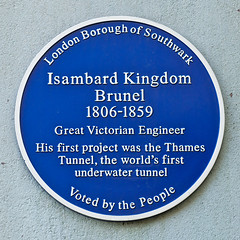

_largest_steamship_of_the_century_was_built_here_by_I.K._Brunel_and_J.Scott_Russell.jpg?width=250)
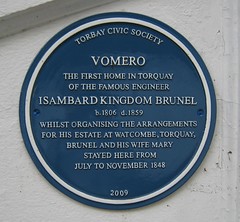
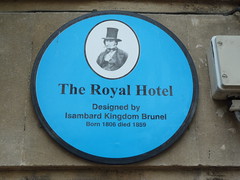


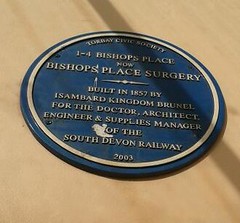
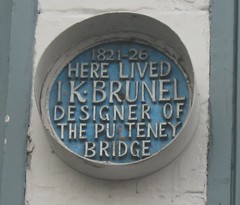
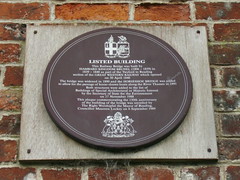


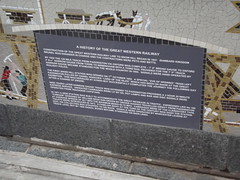



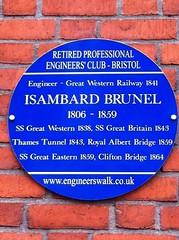

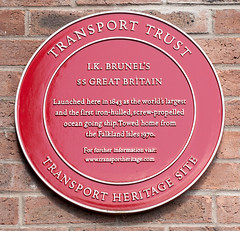


_Bradford-on-Avon_BA15_1DB.jpg?width=250)
